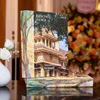Three out of ten artifact groups in the central city of Hue have been listed for recognition as national treasures, including nine sacred cannons, nine urns and a great bell, said an official on Feb. 7.
According to the Nguyen dynasty (1802-1945) history, the nine cannons were cast in Hue by soldiers from February 1803 to January 1804. After being enthroned, King Gia Long ordered the confiscation of bronze weapons from the previous reign, in order to cast the cannons as eternal souvenirs.
They were named after the four seasons and five elements of metal, wood, water, fire and earth, according to Eastern philosophy, and were placed at The Nhon and Quang Duc gates in Hue imperial city in the early 20 th century.
Outstanding symbols of the country’s immortal reign and wealth, the nine urns were cast in late 1835 and completed in early 1837. The tallest urn is 2.5 metres tall and 2,600 kg in weight. The smallest is 2.31 metres high and weighs more than 1,900 kg.
Considered the most valuable bronze works in Vietnam , the urns were carved with 153 patterns, using images such as mountains, rivers, moon, stars, trees, animals, weapons, vehicles and ships.
Meanwhile, the great bell of Thien Mu pagoda was engraved with dragon and phoenix patterns and became a treasure of Thuan Hoa Buddhism.
The 2.5 metre-high bell weighs about 2,000 kg and was cast during the rule of Lord Nguyen Phuc Chu in 1710 for worshipping at a national pagoda./.
According to the Nguyen dynasty (1802-1945) history, the nine cannons were cast in Hue by soldiers from February 1803 to January 1804. After being enthroned, King Gia Long ordered the confiscation of bronze weapons from the previous reign, in order to cast the cannons as eternal souvenirs.
They were named after the four seasons and five elements of metal, wood, water, fire and earth, according to Eastern philosophy, and were placed at The Nhon and Quang Duc gates in Hue imperial city in the early 20 th century.
Outstanding symbols of the country’s immortal reign and wealth, the nine urns were cast in late 1835 and completed in early 1837. The tallest urn is 2.5 metres tall and 2,600 kg in weight. The smallest is 2.31 metres high and weighs more than 1,900 kg.
Considered the most valuable bronze works in Vietnam , the urns were carved with 153 patterns, using images such as mountains, rivers, moon, stars, trees, animals, weapons, vehicles and ships.
Meanwhile, the great bell of Thien Mu pagoda was engraved with dragon and phoenix patterns and became a treasure of Thuan Hoa Buddhism.
The 2.5 metre-high bell weighs about 2,000 kg and was cast during the rule of Lord Nguyen Phuc Chu in 1710 for worshipping at a national pagoda./.



















